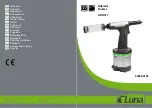
Safety and operating instructions
EN
RRC13
10
© Atlas Copco Industrial Technique AB - 9836 978500 00
• When working above shoulder level, reduce the load on the static mus-
cles by reducing the weight of the tool, using for example torque arms,
hose reels or weight balancers. You can also reduce the load on the static
muscles by holding the tool close to the body.
• Make sure to take frequent breaks.
• Avoid extreme arm or wrist postures, particularly for operations requir-
ing a degree of force.
• Adjust for convenient field of vision by minimizing movement of the eyes
and head during the work task.
• Use the appropriate lighting for the work task.
• Select the appropriate tool for the work task.
• Use ear protection equipment in noisy environments.
• Use high-quality inserted tools or consumables to minimize exposure to ex-
cessive levels of vibration.
• Minimize exposure to reaction forces.
• When cutting:
A cut-off wheel can get stuck if the wheel is either bent or if it is not
guided properly. Make sure to use the correct flanges for cut-off wheels
and avoid bending the wheel during cut-off operation.
• When drilling:
The drill might stall when the drill bit breaks through. Makes sure you
use support handles if the stall torque is too high. The safety standard
ISO11148 part 3 recommends using something to absorb the reaction
torque above 10 Nm for pistol grip tools and 4 Nm for straight tools.
• When using direct-driven screw or nutrunners:
Reaction forces depend on tool setting and joint characteristics. The abil-
ity to bear reaction forces depends on the operator’s strength and pos-
ture. Adapt the torque setting to the operator's strength and posture and
use a torque arm or reaction bar if the torque is too high.
• Use dust extraction system or mouth protection mask in dusty environments.
Country of origin
Please refer to the information on the product label.
Spare parts
Parts without ordering number are not delivered separately for technical rea-
sons.
The use of other than genuine Atlas Copco replacement parts may result in de-
creased tool performance and increased maintenance and may, at the company
option, invalidate all warranties.
Warranty
Contact the Atlas Copco sales representative within your area to claim a prod-
uct. Warranty will only be approved if the product has been installed, operated
and overhauled according to the Operating Instructions.
Summary of Contents for RRC13 Series
Page 25: ...RRC13 FR Atlas Copco Industrial Technique AB 9836 978500 00 25...
Page 37: ...RRC13 DE Atlas Copco Industrial Technique AB 9836 978500 00 37...
Page 49: ...RRC13 ES Atlas Copco Industrial Technique AB 9836 978500 00 49...
Page 61: ...RRC13 PT Atlas Copco Industrial Technique AB 9836 978500 00 61...
Page 73: ...RRC13 IT Atlas Copco Industrial Technique AB 9836 978500 00 73...
Page 85: ...RRC13 NL Atlas Copco Industrial Technique AB 9836 978500 00 85...
Page 96: ...DA RRC13 96 Atlas Copco Industrial Technique AB 9836 978500 00...
Page 107: ...RRC13 NO Atlas Copco Industrial Technique AB 9836 978500 00 107...
Page 118: ...FI RRC13 118 Atlas Copco Industrial Technique AB 9836 978500 00...
Page 129: ...RRC13 SV Atlas Copco Industrial Technique AB 9836 978500 00 129...
Page 130: ...RU RRC13 130 Atlas Copco Industrial Technique AB 9836 978500 00 2006 42 CEN TC 255 1...
Page 131: ...RRC13 RU Atlas Copco Industrial Technique AB 9836 978500 00 131 2 3...
Page 132: ...RU RRC13 132 Atlas Copco Industrial Technique AB 9836 978500 00 4 5 6 7 8...
Page 138: ...RU RRC13 138 Atlas Copco Industrial Technique AB 9836 978500 00 ISO 11148 3 10 4...
Page 141: ...RRC13 RU Atlas Copco Industrial Technique AB 9836 978500 00 141...
Page 153: ...RRC13 PL Atlas Copco Industrial Technique AB 9836 978500 00 153...
Page 165: ...RRC13 HU Atlas Copco Industrial Technique AB 9836 978500 00 165...
Page 166: ......
Page 167: ......











































